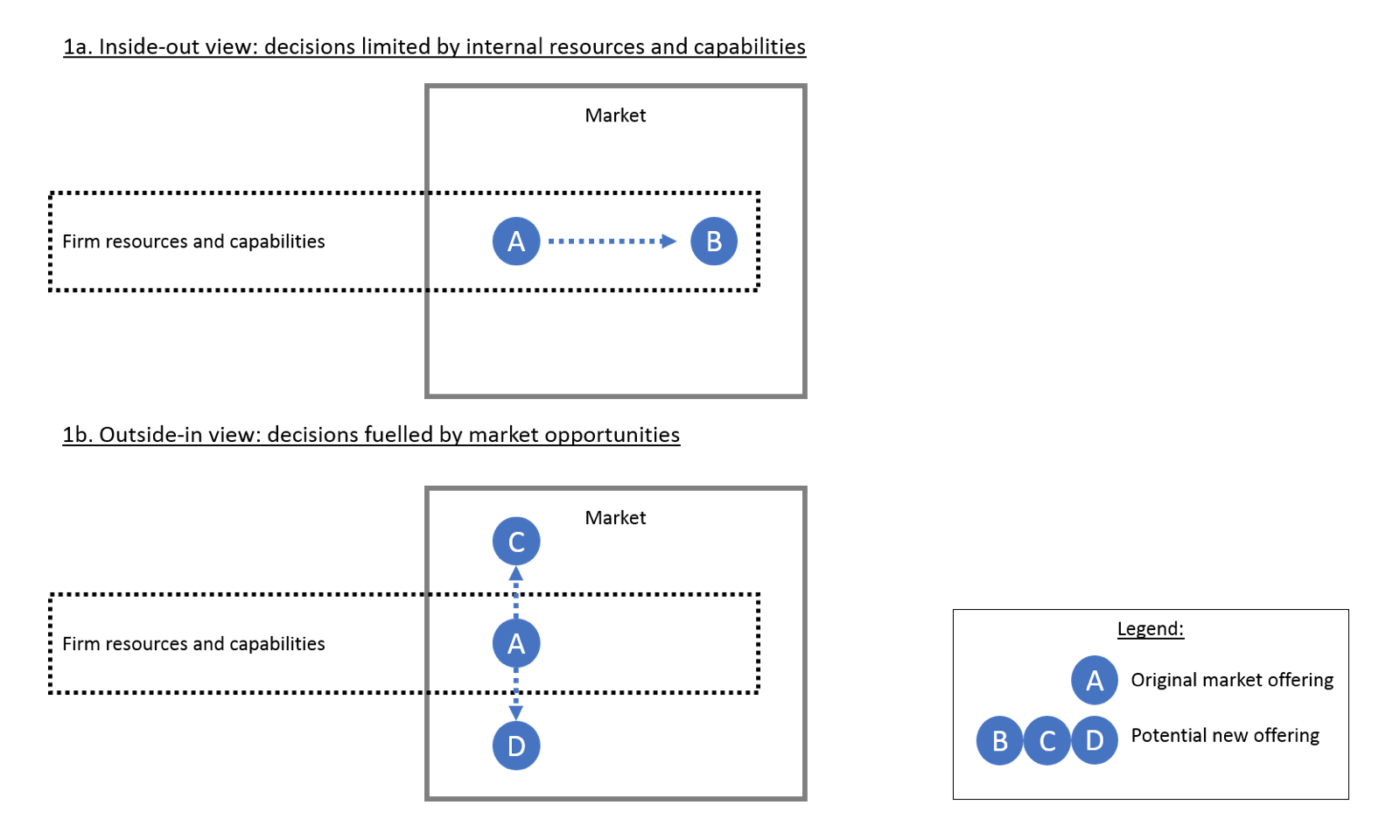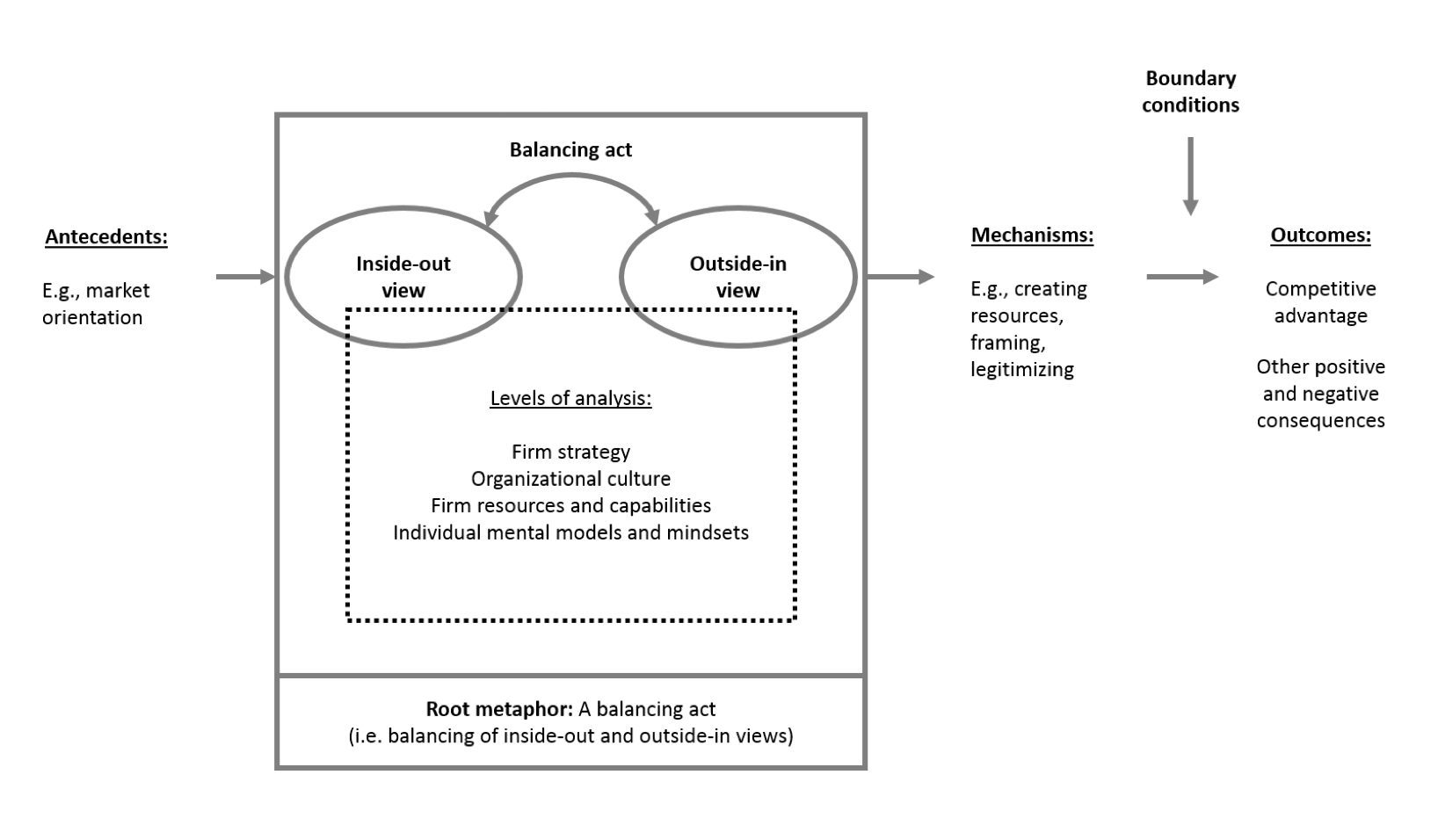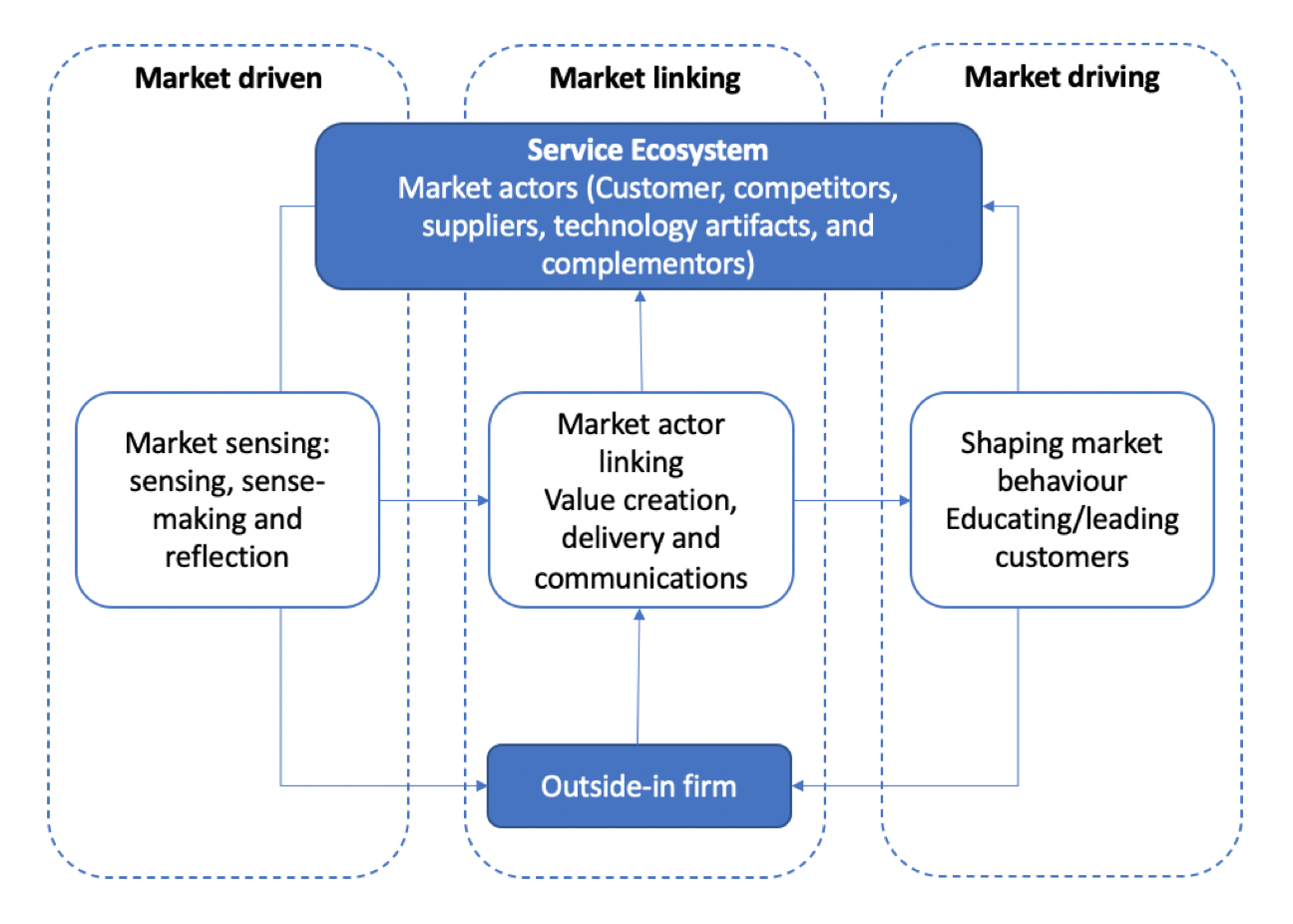California Management Review
California Management Review is a premier professional management journal for practitioners published at UC Berkeley Haas School of Business.
by Jifeng Mu, Park Thaichon, Mika Yrjölä, and Anthony Di Benedetto

Image Credit | JESHOOTS.COM
Philosophical ideologies determine how firms operate their businesses. Traditionally, business strategists and managers follow an inside-out approach based on the resource-based view of the firm for business success.1 This view starts by asking what a company can do with its existing resources, and looks to streamline operations through rightsizing and repressed spending. In practice, inside-out oriented firms ask questions: “How can we invent the future with our resources?”, “How can we make innovative products with our resources?”, and “What can we do with our capabilities given our resources?” However, the inside-out approach to strategy may intrinsically limit the firm’s ability to adapt to major changes in the market. In order to overcome the problems associated with the inside-out approach to problem-solving and capability development, strategists realize that an outside-in approach is needed for firms to compete in the marketplace.2 The outside-in approach is guided by the belief that superior customer value creation is the key to firm success and competitive advantage. Customer value proposition sets the strategic direction regarding target markets, the offering, and the firm’s competitors. In practice, outside-in oriented firms ask questions: “What do our customers need us to do for them given what is going on outside of the firm?”, “What products should we introduce to market given customer need?”, and “What capabilities do we need to develop to create a solution to the customers’ problem?”
“How Can Large Manufacturers Digitalize Their Business Models? A Framework for Orchestrating Industrial Ecosystems” by David Sjödin, Vinit Parida, and Ivanka Visnjic. (OnlineFirst)
“Preparing Organizations for Greater Turbulence” by Paul J. H. Schoemaker and George Day (Vol. 63/4) 2021.
As perspectives on competitive advantage, the outside-in view and inside-out views target and emphasize different sources of competitive advantage. These two views have been used in marketing, management, and elsewhere to characterize whether strategy, marketing capabilities, and mental models begin from an internal (firm) or external (market) starting point. Nonetheless, there have been disagreements on whether the competitive advantage is better explained by outside-in or inside-out views. Proponents of the inside-out view highlight the importance of firm-owned resources and competencies, while proponents of the outside-in view argue that resources and competencies are meaningless if they are easily matched by competitors or do not answer customer requirements. Historically, theories favoring inside-out factors have been in vogue among researchers, while more recently, especially among marketing scholars and strategists, the outside-in view has been gaining ground. Scholars have argued that the inside-out view is inherently myopic and that, in turn, the outside-in view opens more opportunities for competitive advantage. Figure 1 illustrates this line of reasoning. In both cases, the firm is currently competing with offering A and considering alternatives for expansion. In the case of the inside-out view (1a), firms limit their possible growth perspectives according to their current resources and capabilities. In the case of the outside-in view (1b), firms first identify lucrative market positions (i.e. C and D), and then develop new capabilities and resources to be able to expand to those positions.

Figure 1 Illustration of inside-out and outside-in oriented decisions
An outside-in strategy has a reverse order when compared to the inside-out.3 It begins by primarily considering customers and marketplace changes, and only secondarily examining the degree to which the firm can respond to customer requirements and competitor actions, thereby implicitly addressing organizational resources. For example, Procter & Gamble believe that the key to unlocking their new emerging market in Asia and Africa is not about cost efficiency, pricing programs, or distribution capability but is to obtain meaningful and predictive market insights that help P&G create impactful strategies. Such an approach focuses on knowledge, opportunities, and resources that reside outside the firm. Valuable resources are created when firms interact with external entities in competitive, institutional, and cognitive environment, where resources arise both by design and as the unexpected by-products of firm interactions with external entities.
In formulating marketing strategy, based on the outside-in view, companies look at customers and the marketplace and works backward by exploring what the markets and customers are expecting and coming up with solutions from the view of the markets and customers in real time.4 In practice, companies taking an outside-in approach first seek to immerse themselves in the mind of their customers and markets to fully understand customer needs and marketplace changes before designing their marketing strategy and assembling resources (learning and development). Jeff Bezos, Amazon’s founder and chairman, supports an outside-in approach via a “working backward” attitude*“Rather than ask what we are good at and what else can we do with that skill, you ask, who are our customers? What do they need? And then you say we’re going to give that to them regardless of whether we have the skills to do so, and we will learn these skills no matter how long it takes…”5 As such, firms no longer can afford to ignore what is going on outside their realm. They are unable to ascertain they know exactly what the customer and market want if they follow an inside-out approach. What was a valuable resource or advantageous market position can become outdated when consumer needs and technology separately or simultaneously change and rivals dream up new ways of identifying and fulfilling wholly new wants in novel ways that fundamentally challenge the old order.
Business theorists have employed different approaches to explain competitive advantage. As such, both the inside-out and outside-in views, as well as many other approaches in the marketing and management frameworks, are “theories of competitive advantage”. This suggests that the outside-in view is a way to understand the competitive advantage of firms. Therefore, any considerations of alternatives should begin with the root metaphor of thinking. One alternative to a “prioritizing” metaphor would be a “balancing” metaphor. Such an approach would theorize that both inside-out and outside-in views are needed and that a competitive advantage can be orchestrated by firms that succeed in this balancing act. Adopting a balancing approach comprising both perspectives can achieve complementarities that benefit the firm organization. Any more specific alternative assumptions are likely to touch upon the areas of antecedents to, mechanisms of and outcomes of outside-in thinking as well as to any boundary conditions and different levels of analyses. Figure 2, below, presents a framework build on a set of alternative assumptions. Naturally, several alternative frameworks are possible (e.g. institutions could also be a viable level of analysis), but this one illustrates the areas that future theoretical and empirical work should clarify.

Figure 2 The outside-in and inside-out view: Two sides of the same coin
Both the outside-in and outside-in views are clearly important in shaping firm strategy and performance. Theoretically and practically, it is hard to untangle a firm’s internal resources and capabilities and its external market conditions for competitive advantage analysis.6 An either/or narrow trade-off perspective does not represent reality adequately. Opportunity discovery for customer value creation cannot be neatly separated from resource deployment in the firm operation to fufill customer needs. The dual process of opportunity discovery and resource deployment are interdependent across time and space. Over-emphasizing either the outside-in or inside-out view fuels reinforcing cycles risking developing partial and incomplete managerial solutions.
An outside-in firm emphasizes the conditions of the external market to create the best value for customers whereas an inside-out view directs firms to look internally to find what it does best. The long lists of all the possible things, that include resources that companies love to amass in the expectation of long life and success, are misleading. Resources are valuable only to the extent that they can relate to the discovery of market opportunities and customer needs fulfillment. The focus of outside-in and inside-out views is different and often reflects an overarching corporate trait; they can be prioritized by different departments within a firm. For example, the marketing and sales department is often the center of an outside-in approach as they directly interact with customers and the market, and are responsible for collecting insights about customers, competitors, suppliers and channel members, and technology advances. Market insights can be converted into strategies that create superior value to customers and transform the market. This can complement the inside-out view that is usually favored by engineers and technical departments, ensuring that there will be a market before resources are employed to develop new offerings.
Outside-in view suggests that competitive advantage exists in the eyes of customers and is therefore always linked to the target customer group/market, and achieved by anticipating market requirement ahead of competitors. It is this capacity of outside-in firms to see possibilities that others have not seen, and the capacity to inspire and mobilize employees and strategic partners to commit resources to exploit the perceived possibilities that make outside-in firms excel in the marketplace. Competitive advantage is something that allows a company to realize superior performance in a market. It is therefore tied to the creation of superior customer-perceived value via imagination, creativity, problem-solving, and experimentation of employees. In other words, such an advantage is tied to the firm’s ability to market offerings that correspond to customer requirements or key buying criteria in terms of various factors such as price, functionality and image. It answers the question ‘how will the firm compete?’ once a target market is chosen.
An outside-in approach can enable firms to achieve superior performance via their interactions with the market actors. [As such, outside-in approach can be seen as] a typology of social mechanisms. First, the macro–micro mechanisms, labelled situational mechanisms, explain how the macro conditions or contexts influence actors. Second, action-formation mechanisms or the micro–micro-mechanisms describe the actions and interactions between individual actors at the micro-levels. Third, the micro-macro mechanisms or transformational mechanisms explain how actors can influence macro-level levels via their actions and interactions.
The macro-level involves the ecosystem which is defined as relatively self-contained, self-adjusting systems of resource-integrating actors connected by shared institutional logics and mutual value creation through service exchange, the ecosystem that promotes a firm culture that is open-minded, agile, mindful of diverse stakeholders, and boundary-breaking. The micro-level encompasses market actors such as firms, customers and business partners. As outside-in firms place a significant focus on the market and external actors. These acttors are driven by the market ecosystem (a macro-micro mechanism), engage with other actors through active linking (a micro-micro mechanism), and through their interactions and actions, transform the market (micro-macro mechanism). Figure 3 depicts the mechanisms.

Figure 3 Relationship between an outside-in firm and the market
Modern firms such as Microsoft, P&G, IKEA, and Unilever follow market trends and competition by taking a market-driven approach and adopt comprehensive and concentrated growth strategies for their business. These companies successfully deliver value to customers efficiently and effectively by proactively engaging in an exploration of the service ecosystem7 with market-sensing. Central to firm’s market sensing is the vigilance of even the smallest deviations in the market in order to find uncovered market opportunities and to make accurate predictions about reactions to marketing initiatives. Market sensing encompasses capacities to precisely decipher environmental data and promptly uncover and predict market trends, which enable them to quickly respond to dynamic requirements in the marketplace. Market-sensing has three mechanisms: sensing, sense-making and reflection. Sensing involves an open-minded attitude which actively looks for intelligence without confirmation bias, and subsequent comprehensive dissemination of information. This leads to sense-making in which the insights permeate into collective mental models and support effective use of the market intelligence to devise strategies that anticipate instead of merely reacting to market changes. The process of reflection helps to evaluate the effectiveness of the entire market-sensing process and generate testable hypotheses for success.
While market sensing enables firms to be more empathetic to customers, develop unique market insights and discover opportunities and threats, firms need to adapt to the accelerating changes in technology and marketplace. Recognition of market signals enables the firm to create exceptional value by developing game-changing products, building stronger relationships with customers, and generating more sustained differentiation. This is facilitated by the action-formation mechanism or micro-micro mechanism in which firms interact with other market actors in the networks of business relationships: Market linking.
Contemporary firms such as Walmart, Amazon, Google, Apple, and IBM compete and win in the business ecosystems by collaborating with hundreds and thousands of partners to create and deliver products and services to customers. This strategy is called market linking. Market linking is defined as the extent to which organizations establish and maintain long-term relationships with consumers and a purposeful coalitions of partners such as channel members and suppliers, emphasizing the need for networking and importance of social capital in the acquisition of network resources. On this basis, firms can link their capabilities and resources to the external ecosystem to formulate strategies and outperform their rivals. Being able to detect and predict marketplace requirements, outside-in firms can identify important partners and cultivate strong bonds with their partners in order to create superior value to their customers in the business ecosystem. Firms develop collaborative relationships with their key partners via mutual understanding, credibility and trust can co-create value, coordinate activities and share resources. Strong connections with major stakeholders such as suppliers and channel members can assist the firm in crafting their responses to market changes and customers’ specific needs and wants.
By driving market, Apple anticipates trends and takes risk to consistently amaze and surprise customers with delivered value. Market driving is atransformational mechanism, how an outside-in firm devising their actions and interactions with other market actors at the micro-level can generate macro-level outcomes. Market driving refers to the aptitude to predict the future and shape the market.
Market-driving involves explorative behaviors, which challenge existing notions and lead to influencing the structure of the market and/or the behavior(s) of market players in a direction that enhances the competitive position of the business, and push the envelope of possibility and consistently surprise customers by introducing unique value in exceptional novel products and services. Driving the market means that firms need to educate customers and lead their partners, which changes the way a market is structured and how competition evolves. While being market-driven means learning from the market, a market driving perspective means teaching and visionary leaders need to both learn and teach by basing their decisions on a comprehensive understanding of the marketplace, latent needs of customers and unexplored gaps in the market. Doin this require leaders and stakeholders of the firms to continuously improve their judgements via extensive market sensing, accompanied by speedy experimentation to increase their chance of success in driving the marketplace changes. Steve Jobs, Apple’s founder, once said that “…you have to start with the customer experience and work backwards towards the technology”. Since then, Apple has actively engaged in innovations and led the market with its suite of customer-oriented solutions such as iPhone, iWatch and iPad whereas Nokia, once a dominant player in smartphones industry, failed to maintain their leadership due to their inability to innovate based on market preferences. Nokia was fully capable to handle science but they missed the state of customer mind and where their competition was heading. Anssi Vanjoki, Nokia’s head of multimedia, acknowledges, “We read the signs in the marketplace a bit wrong.” Guided by the outside-in view, firms become sensitive to even the very weak signals of imminent changes and exhibits a strong willingness to experiment. Based on market sensing and market linking, firms are able to create innovative products and services that match the latent needs of customers. By doing so, they advance the competition and channel structure, transforming the entire ecosystem.
The unexpected events and situations can bring uncertainty to the market due to changes such as consumer behavior, technology innovation, and government regulation. Not all organizations are ready for dramatic changes. However, companies can survive and even thrive under the new market conditions. Outside-in thinking allows firms to emerge from the radical environmental changes and survive any future times of adversity.
Business agility, the extent to which an entity rapidly iterates between making sense of the market and executing business decisions based on market linking to adapt to the market, as a key element of effectively navigating business management within and through the ever-changing business environment.8 For example, as the COVID-19 pandemic evolves, some firms have quickly updated their marketing communications to be more in sync with customers’ daily circumstances. Brands such as Tesco swiftly focused their messages on what they were actively doing to help, can resonate the most with consumers who are tired of ads that are not authentic or have little practical implications. Tesco provided guidelines about social distancing in-store which was considered very appropriate during the outbreak, and scored highly on long-term return potential, short-term sales likelihood, and brand memorability. Google Japan also immediately moved to adopt a “thank you” message, which emotionally engaged audience and was among a few ads that generated the most positivity during the pandemic. Similarly, in order to promote social distancing and show a commitment to public safety, Chiquita Brands removed Miss Chiquita from their logo while communicating the message: “I’m already home. Please do the same and protect yourself”. As such, by speaking to customers’ mind and hearts in a timely manner, firms can successfully outperform their competitors.
By taking a market driving approach, outside-in firms focus on a vision for the future with a deep sense of purpose, excitement, and motivation for the entire set of actors in the ecosystem, unhampered by traditional thinking and industry norms for innovation, they are poised to make discontinuous leaps in customer value. This makes the outside-in firms more prepared and able to lead the market even in the most troublesome times. For example, Facebook has been experimenting with Horizon, a social virtual reality platform, which can be the future of social media marketing. This technology not only can transform online user experience but also has considerable potential considering customer behaviors have changed significantly and many of them are seeking new forms of entertainment and escapism. This reflects in the market driving mechanism in which firms are able to educate customers and restructure the market.
Robert Grant (1991). The resource-based theory of competitive advantage: Implications for strategy formulation. California Management Review, 33(3), 114–135.
Jifeng Mu (2015). Marketing capability, organizational adaptation, and new product development performance. Industrial Marketing Management, 49, 151–166.
Danny Miller, Russell Eisenstat, and Nathaniel Foote (2002). Strategy from the inside out: Building capability-creating organizations. California Management Review, 44(3), 37–54.
Jifeng Mu, https://cmr.berkeley.edu/2021/06/building-real-time-marketing-capabilities/
Daniel Lyons (2010). The customer is always right, Newsweek, January 4, 85–86.
Rebecca M. Henderson and Will Mitchell (1997). The interactions of organizational and competitive influences on strategy and performance. Strategic Management Journal, 18, 5–15.
David Sjödin, Vinit Parida, Ivanka Visnjic (2021) How Can Large Manufacturers Digitalize Their Business Models? A Framework for Orchestrating Industrial Ecosystems. California Management Review, forthcoming, https://doi.org/10.1177/00081256211059140
Paul Schoemaker, George Day (2021). Preparing Organizations for Greater Turbulence. California Management Review, 63(4), 66–88.